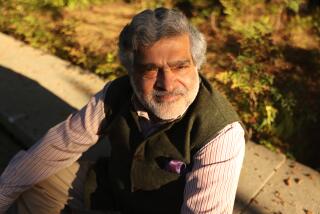Making peace in Atlanta
- Share via
ATLANTA — A much-needed storm drenched Atlanta on Oct. 22, the day the Dalai Lama spoke to thousands in Centennial Olympic Park. For many, his words brought the kind of water that nourishes the seeds of compassion and humanity.
On that day, Emory University installed the Dalai Lama as a presidential distinguished professor. He joins former President Carter and the Rev. Martin Luther King Jr., both of whom have important and impressive sites here, as the third Nobel peace laureate associated with Atlanta.
This city in the northwestern part of the state has long been at the forefront in many arenas: commerce, government and culture. But now, it also has emerged as a world center of humanitarian thought and work, a place where multiple institutions are engaged in furthering world peace and compassion.
And the growth will continue. Ground is scheduled to be broken next year on the Center for Civil & Human Rights, next to the new World of Coca-Cola and the Georgia Aquarium, both heavily visited. The center will house King’s papers, and global conferences on civil and human rights will take place there.
A trip to Atlanta might ordinarily include a visit to the house where Margaret Mitchell wrote “Gone With the Wind,” plus shopping, galleries or museums, catching one of the city’s professional sports teams or a visit to Six Flags Over Georgia. But now a trip here can be a sort of quest to see a world that could be. It’s a fitting goal for a place once known as the City Too Busy to Hate.
--
TIES TO EMORY
Atlanta may seem an unlikely place for the Dalai Lama to visit, but there’s a connection that dates back at least two decades. He first visited Emory in 1987 and returned in 1995 to give talks, said Geshe Lapsang, a former monk, assistant to the Dalai Lama and a faculty member at the Atlanta university.
In 1989, monks touring North America with “The Mystical Arts of Tibet,” an exhibition of sacred dance, art objects and mandala sand painting, encountered a group of practicing Buddhists in Atlanta. That group wanted to establish a connection between the city and India’s Drepung Loseling Monastery and Institute of Buddhist Dialectics, the seat of the Tibetan government in exile.
Two members of the Atlanta group donated the land, founding the Drepung Loseling Institute ( www.drepung.org) in the nearby Blue Ridge Mountains.
In 1998, the Emory-Tibet Partnership was established to encourage educational exchanges and greater awareness of Eastern and Western thought. These developments have led, Geshe said, to “an unprecedented and bold step.” One of the most ambitious projects of this partnership has been an initiative to develop and implement a comprehensive science education curriculum for Tibetan monastics.
As a presidential distinguished professor, the Dalai Lama will make periodic visits to Emory to lecture and participate in the exchange of spiritual and scientific information. It’s easy to picture him, clad in crimson-and-saffron robes, eyes twinkling behind his glasses, walking through Emory’s Druid Hills campus, with its beautiful old Georgia marble buildings, followed by a swarm of students.
Those interested in timing their trips to coincide with the Dalai Lama’s presence at Emory can check www.dalai lama.emory.edu for updates. Visitors can still catch “Buddha in Paradise: A Celebration in Himalayan Art,” which continues through Nov. 25 at the Michael C. Carlos Museum on campus.
In any case, there could be scenes such as these in October at Centennial Park: College guys spelled out H-E-L-L-O D-A-L-A-I in paint on their bare chests; the occasional protester claimed, “He’s sending them all to hell”; and other attendees sat rapt as a gentle mist surrounded the stage where the Dalai Lama spoke.
--
ATLANTA’S OWN
Long before most Atlantans had heard of the Dalai Lama, another leader preached change through nonviolence, also inspired by an Asian leader.
King took many of his teachings from the writings and speeches of Mahatma Gandhi, leader of India’s independence movement. But only in visiting the Martin Luther King Jr. National Historic Site ( www.nps.gov/malu) does the root of the inspiration become clear.
A statue of Gandhi stands outside the visitor center, with its permanent exhibits -- “Courage to Lead,” which describes and shows the journey of the pioneer civil-rights marchers; and “Children of Courage,” an interactive exhibit that shows children’s contributions to the movement and invites young visitors to respond to what they see.
You can sign up for a ranger-led tour of King’s modest birthplace, where whole families take each other’s pictures outside, and continue your walk along Auburn Avenue through the neighborhood known as “Sweet Auburn,” so-called because it was once considered “the richest Negro street in the world” and was home to a large black-owned newspaper, an insurance company, a nightclub and multiple churches.
Although the area fell into disrepair in the 1960s and ‘70s, many of the homes -- dating from the turn of the last century to the 1930s -- have been rehabbed to their former charm, as part of an ongoing effort to reclaim the historic neighborhood. It’s easy to imagine neighbors calling out to one another from their porches in the warm twilight, as children play nearby.
King was co-pastor with his father at Ebenezer Baptist Church on Auburn, also the site of many early civil-rights meetings and of his funeral in 1968. The church is closed for restoration, but when it reopens in late 2008, visitors will again be able to sit in a pew and listen to the taped sermons of King, a moving experience.
The family continues to operate the King Center and Tomb, across Auburn from the visitor center (www.theking center.org). It has a room dedicated to Gandhi, filled with artifacts of his life, including a piece of cloth spun by the Indian leader. Other rooms celebrate the lives of King and his wife, Coretta Scott King. The center marks Gandhi’s birthday each year, as well as King’s.
The site was crowded the day of my visit in early July. Visitors of different races and ages mingled as they walked through the visitor center and studied exhibits, watched short videos and posed for pictures within the life-size sculptures of civil-rights marchers.
As I viewed pictures of grim-faced men, their hands clenched in hatred, and gazed at a replica of a streetcar with sections marked “colored” and “white,” I was overcome by the notion of how far Americans have traveled -- and how far we have yet to go.
--
LAUREATES’ TRAIL
If you have time, take the 1 1/2 -mile Carter-King Peace Walk, which connects the historic King site with the Jimmy Carter Library & Museum, and serves as a link between the two Georgia laureates.
Carter remains an active voice for humanitarian causes, as his recent visit to Darfur suggests.
By visiting the Carter site (www .jimmycarterlibrary.gov), 10 minutes by car from downtown on 35 beautifully landscaped acres, I got a glimpse of just how diverse these causes can be.
Exhibits such as “Beyond the Presidency: 25 Years of the Carter Center” (through Nov. 25) highlight the center’s work on eradicating diseases, such as Guinea worm in Africa, election observations in 26 countries, and helping to create peace processes in places such as Ethiopia and Bosnia-Herzegovina.
I walked through “Beyond the Presidency” and later a full-size re-creation of the Carter-era Oval Office and exhibits on the major events of his presidency. Like the Dalai Lama, Carter is a presidential distinguished professor at Emory and shares with students thoughts such as this, seen in a library brochure: “Self-governance, freedom from political persecution, adequate food, and access to health care -- these rights give people self-respect, human dignity and hope for the future.”
I sat in the tranquil Japanese garden outside the library and dreamed of a compassionate future.
Atlanta continues to struggle with issues of race and human rights, but like its symbol, the phoenix, the city is re-creating itself, this time on a global scale. And this time, the phoenix looks very much like a white dove.
--
(BEGIN TEXT OF INFOBOX)
Planning this trip
THE BEST WAY
From LAX, Delta and Air Tran have nonstop flights to Atlanta. Delta, American, U.S. Airways, Northwest, Continental, Frontier and United have connecting flights. Restricted round-trip fares begin at $356.
WHERE TO STAY
The Grand Hyatt Atlanta, 3300 Peachtree Road N.E.; (404) 237-1234, www.grandatlanta.hyatt.com. The 438-room hotel offers luxury in the upscale Buckhead neighborhood. Friendly, welcoming staff adds a touch of Southern hospitality. Doubles from about $275.
Hotel Indigo, 683 Peachtree Street N.E.; (404) 874-9200, www.hotelindigo.com.
The 140-room hotel, a division of Intercontinental, is in the centrally located, very happening Midtown area. The brand is casually chic, with wood floors in the rooms and Aveda amenities. The Midtown Indigo offers a small, fun bar, outdoor seating on main artery Peachtree and is dog-friendly. Ask for a room on the 12th (and top) floor. Rates from about $100.
WHERE TO EAT
Atlanta is a foodie town. You’ll find trendy restaurants side by side with down-home Southern cooking.
The Flying Biscuit Cafe, www.flyingbiscuit.com. An Atlanta favorite (now becoming a franchised chain). With three locations, you’re never too far from its famous homemade biscuits and great coffee.
Thrive, 101 Marietta St.; (404) 389-1000, www.thriveatl.com. In the Centennial Tower, a block from the CNN Center. This hip hangout turns into a groovy lounge scene at night. The sushi bar serves dishes such as a cornmeal- crusted grouper sandwich with fried green tomatoes ($12). Sandwiches and entrees from $12.
R. Thomas’ Deluxe Grill, 1812 Peachtree Road N.W.; (404) 872-2942, www.rthomasdeluxegrill.com. A one-of-a-kind place that looks like it belongs in Berkeley in the ‘60s. You can get your organic on from breakfast through dinner. Entrees from $10.
Six Feet Under, 684 11th St.; (404) 810-0040, www.sixfeetunderatlanta .com. Across from Oakland Cemetery, this place is an ideal respite after a couple hours of tomb hunting. Seafood entrees around $10.
Ronnie & Folami’s Home Cooking, corner of Irwin and Howell streets, around the corner from the Martin Luther King Jr. National Historic Site; (404) 454-8061. A local find featuring “deluxe chicken and ribs, yams and greens” (from $8.50).
On travel.latimes.com
In Atlanta, the peace process has many faces: college kids as well as a Carter. See latimes.com/atlanta.
--
The Nobel laureates
The Rev. Martin Luther King Jr.
Social activist, pastor
Born: Jan. 15, 1929, in Atlanta
Died: Assassinated April 4, 1968, in Memphis, Tenn.
Accomplishments: Led U.S. civil-rights movement. Emerged as a force in 1955, with the Montgomery, Ala., bus boycott. A founder of the Southern Christian Leadership Conference, 1957. Led the March on Washington, 1963. Nobel Prize, 1964.
Jimmy Carter
President, diplomat, author
Born: Oct. 1, 1924, in Plains, Ga.
Accomplishments: 39th president of the United States (1977 to 1981) in a term marked by unstable economic conditions, including rising inflation and unemployment, at home and a diplomatic crisis in Iran. Lost to Ronald Reagan after one term and became known for international diplomacy in such hot spots as North Korea and Haiti. Nobel Prize, 2002.
Dalai Lama
Tibetan spiritual leader
Born: 1935, Qinghai province, in what is now China.
Accomplishments: 14th Dalai Lama, became head of state in 1950, fled to India in 1959 when Chinese sent troops to stop an uprising. Nobel Prize, 1989. In October, received the Congressional Gold Medal. President Bush called him a “man of peace and reconciliation”; China said the honor undermined U.S.-China relations.
More to Read
Sign up for Essential California
The most important California stories and recommendations in your inbox every morning.
You may occasionally receive promotional content from the Los Angeles Times.













